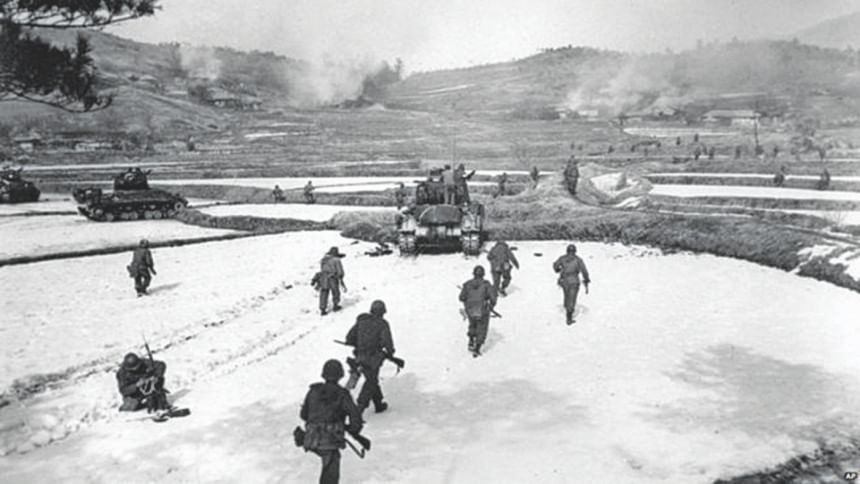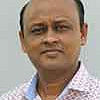Living with a hostile brother

South Korean soldiers still regularly drill in the Korean Demilitarised Zone in the hope of finding no mineral resources, but more infiltration tunnels constructed by their rival North Korean troops.
Between 1974 and 1990, they discovered four tunnels constructed by the North Korean soldiers to invade the South in surprise attacks in case war broke again.
The discovery of the third tunnel in 1978 was the most thrilling.
A North Korean defector had brought a piece of chilling information for South Koreans in 1974. He had disclosed that North Korean military constructed another tunnel in DMZ only 44km from Seoul, which is less than an hour's drive.
Following a hectic search, Korean soldiers discovered the third tunnel. It is almost identical in structure to the second tunnel which was discovered in 1975.
The third tunnel is 1.6 kilometer-long, 1.95 meters high and 2.1 meters wide. As many as 30,000 troops can move through this per hour.
Initially, North Korea denied building the tunnel and officially declared it as part of a coal mine. Black "coal" was painted on the walls by retreating soldiers to help confirm this statement.
However, the South has found no geological proof of coal being in the area.

According to South Korean military officials, North Korea began digging tunnels under the DMZ in 1974 following an order issued by Kim Il-sung, the then president of North Korea.
In this order, he stressed the need for digging tunnels under the DMZ, saying that one tunnel would be more effective than 10 atomic bombs and would thus be the best means to overwhelm the heavily fortified front.
The third tunnel is now a tourist attraction. Every day, a few thousand tourists visited the tunnel and the adjacent spots.
This correspondent along with around 80 more journalists from 50 countries visited the areas and climbed down into the tunnel on April 22.
A South Korean army officer at Dora observatory located at the top of the mountain in Paju briefed journalists about the situation in the border area.
The Dora observatory is the closest to North Korea within South Korea from where one can see North Korean households without actually crossing into the DMZ that split the Korean peninsular in half creating a buffer zone between North and South.
According to army officials of Dora Observatory, around 70 percent of the South Korean soldiers are deployed in the border line to defend their territory from any possible attack by North. A huge number of troops of North has also been stationed in their parts. Therefore, it has been the most militarised border on the earth.
DMZ was established by the UN in 1953, when the Korean War Armistice was negotiated. It is about 160 miles (250km) long, running from the Sea of Japan (East Sea) in the east to the East China Sea in the west.
The two Koreas exchange fire across the line fairly regularly.
"We are still at war with North Korea. The war ended in 1953. Yet, neither side signed a peace treaty. The peace treaty should be signed by the two Koreans," says Woosuk Keneth Choi, deputy editor of strategic planning news desk of Chosun Daily Newspaper in South Korea.
In views of Professor Hong Duckryul, president of Daegu University of South Korea, the reality of the Korean peninsula is still precarious.

"North Korea has continued its nuclear weapons development and test missile launches while South Korea and the United States have responded with the largest military exercise since the Korean War armistice," he said in a recent conference on denuclearisation of Korean peninsula.
Defying international community's outcry and UN sanction, North Korea kept developing nuclear weapons and it declared itself a nuclear power in 2005.
The United States, Japan and South Korea, as well as Russia and China, have joined talks with North Korea on the denuclearisation of the Korean peninsula between 2003 and 2009. But Pyongyang withdrew from the talks.
"The six-party talks have all but vanished, and tensions on the Korean peninsula continue to increase. The Korean peninsula still cannot escape from the horrors and instability of war, nor abandon the fetters of its Cold War past," stated Prof Hong.
The armistice agreement brought the ceasefire in 1953. The end of the Korean War however could not defused tensions between the two.

There were many incidents in the last six decades which were the manifestation of the tensions. North Korea was also accused of making attempt to assassinate South Korea's president in 1968.
In 1983, a bombing in Myanmar that was linked to North Korea, killed 17 South Korean officials and in 1987, North Korea was accused of bombing a South Korean airplane.
In 2010, tensions between North and South Korea were particularly high after a South Korean warship was sunk on March 26.
In November 23, 2010, North Korea launched an artillery attack on the South Korean island of Yeonpyeong. Yeonpyeong was also attacked in January 2009.
Recently, Pyongyang openly threatened a pre-emptive nuclear strike against the Republic of Korea and the US.
WHY SOUTH DESPERATE FOR PEACE
Over the past four decades, South Korea has demonstrated incredible economic growth and global integration to become a hightech industrialised economy.

It now claimed itself as the 15th largest economy in the world. Massive infrastructure development works have been carried out in past while many projects are underway.
But its aggressive neighbour North Korea appeared as a major threat to all the developments in South. A war may cause severe blow to the South's economic growth as it faced in 1950s during the Korean War when the North invaded the South.
"We can no longer afford to be pushed around by North Korea's deceit and intimidation," says Lim Sungnam, vice minister of foreign affairs of South Korea, in the conference on denuclearisation of Korean peninsula.
Like the vice minister many South Koreans speak for peace at any cost for safety of its economic growth and development.
"Seoul will also play its part in opening up a peaceful future," said Park Won Soon, Mayor of Seoul metropolitan government, at the dinner he hosted for visiting journalists.
He said Seoul and Pyongyang are only 240 kilometers apart from each other. "We will pursue city diplomacy with Pyongyang and build mutual trust and respect. We will strive for exchanges with Pyongyang in areas such as culture, arts, and sports."
South Korean media is also much careful in their reporting to avert war.
Senior journalist Woosuk Keneth Choi says they have extra burdens when it comes to reporting about their own military conflicts in their territory.
"When North Korea tests nuclear bombs and fires missiles, most South Korean media condemns such actions as the global media does. Yet we take very cautious steps when reporting because the Korean media does not want to push the situation to the brink of war. This is the matter of our own life and death issue," he stated.

MEDIA VS NEUCLEAR WEAPONS!
In its latest move for peace, South Korea Journalist Association in support of the government has held a conference on April 7 in Seoul on denuclearisation of Korean peninsula with participation of around 80 journalists from 50 countries.
Through this move, they sought to build world opinion in their favour.
The conference highlighted the role of media to bring peace in the Korean peninsula.
"Our efforts to bring North Korea to the right side of history through negotiation have not achieved the desired outcome yet," said the vice minister of foreign affairs.

Professor Hong Duckryul, president of Daegu University of South Korea said Korean peninsula is now, more than ever, in desperate need of help from journalists around the world who feel a responsibility towards world peace.
"It is my hope that journalists from around the world will play an active role, so that South Korea can serve as a valuable asset of humanity," said the professor.
In his views, the press is virtually the only mechanism that can handle communications within Korea, between the two Koreas, and furthermore, at a global level.
The mayor of Seoul Metropolitan government said journalists can play a crucial role in the denuclearisation of the Korean peninsula. "If you can go out into the world and write about easing tensions and resolving peace, we can open up a new peaceful chapter in the history of the world together."
YET, HOPE FOR UNIFICATION
They were unified for centuries under the Joseon Dynasty from 1392 to 1910, and share the same language and culture.
The present crisis began with the Japanese conquest of Korea at the end of the nineteenth century.
The Empire of Japan formally annexed the Korean Peninsula in 1910. The end of World War II brought new scenario in the peninsula. Japan was defeated to the Allied forces that took over administration of Japan's occupied territories, including Korea.
But desires of the two superpowers made situation complicated. The US wanted the entire peninsula to be democratic and capitalist; the Soviets wanted it all to be communist.
Finally, Korean peninsula was divided into South and North.
This division started the conflicts between South and North because the northern region followed the USSR and became communist, while the south opposed this form of government and formed a strong anti-communist, capitalist government.
Once the two Koreas were formally established, top leaders of two Koreas worked to reunify Korea. But this caused conflicts because each wanted to unify the area under their own political system and rival governments were established.
By 1950, the conflicts on the border of North and South Korea led to the beginning of the Korean War.
In the past six decades, there were many efforts to reunify Korea.
Even South Korean President Kim Dae-jung articulated in 1998 Sunshine Policy, the foreign policy towards North Korea. It was his foreign policy which emphasized peaceful cooperation, seeking short-term reconciliation as a prelude to eventual Korean reunification.
During the decade of its implementation until 2008, political contact between the two nations increased, several high-profile business ventures launched, and brief meetings of separated family members were facilitated. In 2000, Kim Dae-jung received the Nobel Peace Prize for his Sunshine Policy initiative.
But, unification remains a distant cry. Tensions between two Koreas keep increasing.

 For all latest news, follow The Daily Star's Google News channel.
For all latest news, follow The Daily Star's Google News channel. 



Comments